King Kong is the modern remake of the 1933 classic, which follows Carl Denham (Jack Black) in his attempts to film a movie by coercing his cast and crew into following him on his voyage. His voyage is an attempt to find the mysterious Skull Island where he hopes to film the ‘last blank space on the map’; however, it quickly becomes a battle for life and death once their leading lady Anne Darrow (Naomi Watts) is kidnapped by a great beast. The film then focuses on the ever-growing relationship that Anne has with the giant ape Kong whilst simultaneously showing the crews efforts to save her, led by Jack Driscoll (Adrien Brody) the scriptwriter for the film and Anne’s love interest. Eventually the crew save Anne and capture Kong, bringing him as their captive back to New York. Inevitably, he escapes and in an effort to find Anne, he rampages through the city whilst being pursued by the army. The climactic scene is one of the most famous in all of film, as the most powerful beast in the animal kingdom is butchered atop the peak of human civilisation, the Empire State Building.
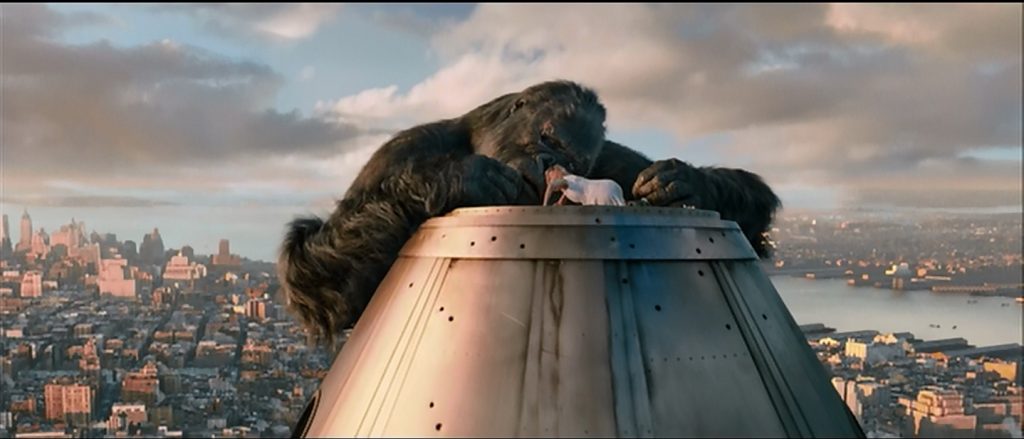
Peter Jackson attempts to make King Kong a more complicated narrative than the original was, this is achieved in part through emphasising the almost romantic relationship that Kong has with Anne. Instead of the film being simply an action adventure epic, he introduces romantic themes throughout the film; this was an important decision for Peter Jackson to make and had repercussions to the way in which the human animal relationship was explored within the film. It allowed the audience to experience much more sympathy for the beast despite his attempts to kill Jack Driscoll. As a result, the overriding motifs that are present within the film, such as the encroachment of modern civilisation on the natural world, are more effectively conveyed to the audience given their strong emotional involvement with Kong. Jackson also utilises a common technique of writers and filmmakers to anthropomorphise animals, allowing the audience to empathise with the plight the animal is going through. Whilst Jackson wanted to keep the film as realistic as possible, he comments in a 2005 interview that, ‘as filmmakers… there’s a little bit of cheating to make a moment work. If it is not something a gorilla would not naturally do, we tried to make it look as close as possible[1]’. However, the film does remain primarily an action adventure film, which is crucial as it highlights Hollywood cinemas tendency to engage audiences to think of animal as either innocent or evil. Whilst this may not be intentionally done, Jackson continues a trend in action films to position predatory animals as mindless creatures’ intent on killing humans solely in an effort to increase action and suspense within a film. This intensifies the stereotype of animals as simply one-dimensional creatures’ further encouraging people to view them as binaries from us as they are not seen as emotional or complicated creatures.
This perpetuation of the view that animals are either evil beasts or innocent creatures is in part due to Hollywood cinema, with directors assigning animals either of these simplistic traits to fit their narratives aesthetic. Take the Lion King (1994) for example; where the animals within the film are depicted as either good or evil, the hyenas are presented as sly and evil creatures whilst Simba is a character shown as majestic and benevolent. This occurs continually with the animals on Skull Island, as the predatory beasts that live there all seem solely intent on killing the hapless crew. Whilst this may appear to be simply as a result of the action nature of the film and the need for violence, it nonetheless offers a clear insight into the relationship humans have with animals in film. Directors and writers so easily manipulate peoples’ shallow views on animals to reduce the animals to unrealistic caricatures of themselves, for example in King Kong, the T Rex continues its position in cinema as a mindless man eater as it tries to kill and eat Anne. This is an unrealistic portrayal of animals and highlights how little care audiences and writers alike share for these animals, as they have no trouble in believing these creatures would behave this way. Peter Jackson took pride in making this film as realistic as possible, rewriting his original script from 1996 in order to achieve this realism. Given his experience with The Lord of the Rings trilogy Jackson believed that giving fantasy films a more grounded sense of realism made them a much more enjoyable experience for audiences of all ages. Yet, whilst he admits that there may be moments within the film where Kong behaves slightly unrealistically, he does not even feel the need to address how the predators on Skull Island other than Kong act in a completely one-dimensional way. Ultimately, this is a more important demonstration of the human animal relations rather than even the intentional themes Jackson wished to portray within his film. This is because it highlights the subconscious debasement of animals to exhibit one emotion that fits the stereotype people automatically assign to certain animals, be it predator or prey, evil or innocent. Coming back to the example of the T Rex’s, Kong is fighting three of the pre historic beasts to the death and all they seem to focus on is eating Anne which would be barley be a mouthful for these giant creatures.
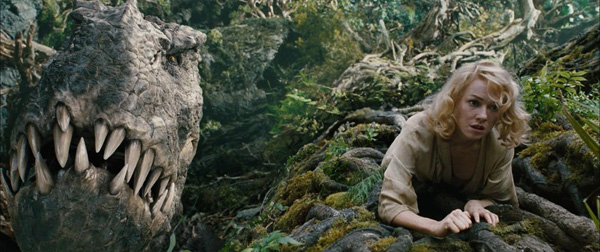
It shows how human-centred we perceive the attention of these animals to be on us, it is similar to many epic Hollywood films such as Jurassic Park. There are many striking similarities between these two films as the animals in both cases seek only to attack and kill humans regardless of how it affects them. Whilst it can be said this is simply a device for making these films more exciting for the audiences, it almost subliminally effects the way these audiences view animals as there is no grief or moment of sympathy when these one dimensional presentations of animals are so quickly killed on screen.
Consequently, this portrayal of animals within King Kong, and many other action films where the animal is a danger to the protagonists, leads them to be seen as one-dimensional beings as they appear to only function to kill with no complicated emotions. This inevitably encourages audiences to think of animals as something entirely different to humans, pushing us away from the fact that we ourselves are animals and instead portraying us as a supremely omnipotent species not worthy to be classified as animals. As a result, these types of films enable people to view animals and humans as binaries, something that negatively effects peoples’ perceptions of animals. Skull Island becomes a metaphor for these binaries and also the encroachment of civilisation on animals’ natural habitats. The film acts to highlight the importance of Skull Island as a metaphor for the final parts of the world that are yet to be discovered, with Carl Denham exclaiming, ‘We’re gonna find Skull Island! We’re gonna find it, film it and show it to the world. For twenty-five cents you get to see the last blank space on the map’. Ultimately, Peter Jackson is highlighting the greed of humans as they have no trouble commodifying the ‘last’ untouched piece of natural habitat in the world, signifying humans’ continual encroachment on animals and nature in general. In a book analysing eco trauma in cinema, Anil Narine comments that ‘Peter Jackson’s film points to the theme of eco trauma by mourning the end of Nature on Skull Island. Kong is captured, chained and put on display[2]’. This combines two important elements of the human animal relationship within the film, that modern humans encroach and destroy the sanctity of nature that is enabled by our shallow belief of human and animal binaries.
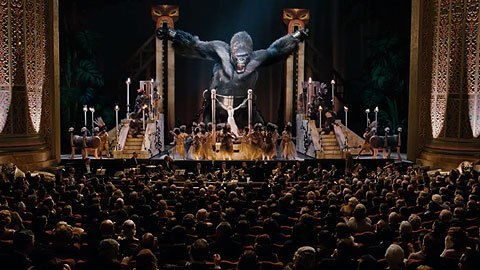
It is through this belief of animals as being entirely different from us and being one-dimensional creatures that allows modern humans to view them simply as commodities and treat them as such without feeling guilt. Kong himself becomes the literal representation of exploiting animals for money, with the king of the animal kingdom reduced to nothing more than a circus act intended to bring in money for Carl Denham. In the particular scene Jackson shows the submissive attitude of Kong with close ups of the apes face showing his resignation of defeat. It is a moment that is important within the context of the film, as Jackson has carefully cultivated Kong as a creature that the audience is sympathetic to and is now asking the audience to realise the horrors of this exploitation. As a result, King Kong can be viewed almost as a real life exploration of how people have behaved when it comes to nature, highlighting the sense of entitlement that people have thinking that they can do with animals as they please.
Skull Island itself also becomes emblematic of these binaries in motion and the separation of humans and animals; this is achieved through the great wall that literally and symbolically divides the humans of the island with the animals and nature that live on the other side.
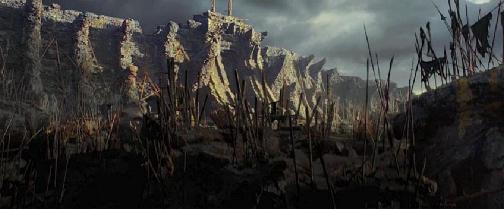
The cinematic techniques employed by Jackson make the film stylised in always appearing as if there are opposing forces at play, similarly to the wall Jacksons cinematic shots attempt to convey this barrier and opposing forces in conflict. A key depiction of this comes when Anne stands between Kong and the T Rex, the wide shots used indicate this feeling of conflict and division with both forces standing opposite one another on either side of the frame. Ultimately, Jackson is showing the eternal violent conflict that occurs between animals and humans because of society’s tendency to situate the two as binaries.
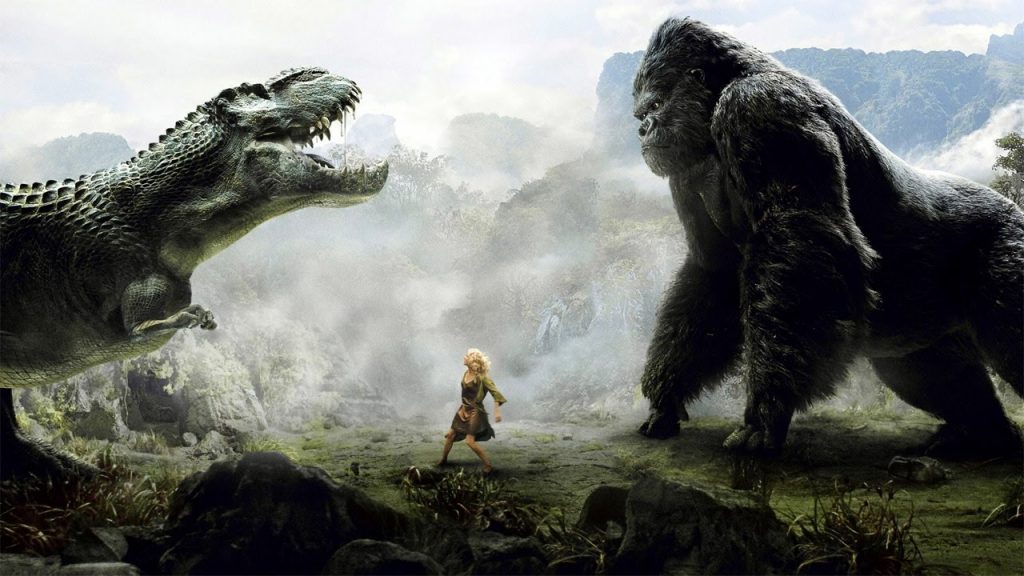
When looking at King Kong it is more interesting to analyse how the other animals within the film that are not Kong are portrayed. This is because Kong himself is a creature that, as the character Lumpy describes, was ‘neither beast nor man’. He is not a true representation of animals and not treated as such by the audience or director as he is designed to be relatable to the audience. Jackson imbues him with many human like qualities and anthropomorphises him more so than in the King Kong films, this is emphasised by the lack of emotion and personality given to the other animals within the film and the consequential stark contrast they have with Kong. As a result, the predators of Skull Island are more indicative of the human animal relationships. They highlight how Hollywood cinema so easily utilises animals to play a base emotion, in this case as violent man-eaters, which in turn audiences so easily consume. It in effect only intensifies the belief of binaries within human society regarding humans and animals, in many ways simply mirroring the behaviour of humans in real life.
Whilst Jackson may have been attempting to show the audience how modern humans have wantonly encroached on nature with disastrous effects for animals, he inadvertently shows how little has changed within Hollywood cinema for the majority of animals. King Kong (1933) and King Kong (2005), despite being over seventy years apart, similarly show how animals are continually used within cinema as if they are monsters in a horror film. Unfortunately this mirrors largely the attitude of humans toward animals in real life where humans treat animals as if they are not living things and are there for us to do with as we please.
[1] Peter Jackson, ‘King Kong’, BBC (2005) < http://www.bbc.co.uk/films/2005/12/09/peter_jackson_king_kong_2005_interview.shtml >(Accessed 3rd January 2019)
[2] Anil Narine, Eco-Trauma Cinema (New York: Routledge, 2015), p. 42.
Bibliography
Desilets, Sean, Hermeneutic Humility and the Political Theology of Cinema: Blind Paul (New York: Routledge, 2017)
Jackson, Peter, King Kong (BBC 2005), http://www.bbc.co.uk/films/2005/12/09/peter_jackson_king_kong_2005_interview.shtml
Narine, Anil, Eco-Trauma Cinema (New York: Routledge, 2015)